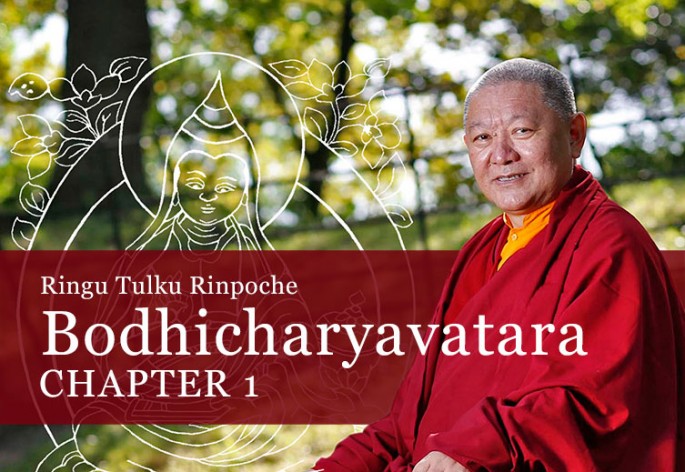BA1_7-8 The General Benefits of Bodhichitta
With the video BA8/BA1_7-8 Rinpoche gives an explanation of the 7th and the 8th stanza of the first chapter of the Bodhicharyavatara. These verses continue on the general benefits of bodhichitta which was started in stanza six.
To view the video, simply click on the image to view all the Chapter 1 videos.
If you prefer listening to the teaching in audio, use the audio player below.
The audio as well as the audio translations in different languages and the transcript of this teaching are all available on Chapter 1 page.
We are also studying the commentary transcript on Chapter 1, which you can download here and in the Library section. Further recommended reading: the commentary book by Kunzang Pelden (Khenpo Kunpal), The Nectar of Manjushri’s Speech, p. 46-47.
You’re questions are most welcome. Please log in and leave your questions for Rinpoche as a comment below, or send them via email to studyquestions[at]bodhicharya.org. It is helpful if you can use one short paragraph and, if possible, less than 80 words. Any questions longer than that may have to be edited so please be concise. Questions will be collected from here on November 24, 2010, and included in Rinpoche’s answers video. After that date please send any questions relating to this video teaching via email to studyquestions[at]bodhicharya.org.
If you would like to volunteer in making transcripts of Rinpoche’s online teachings, or in making audio translations to your own language, please email us at shedra[at]bodhicharya.org.
If you would like to make a personal offering to Rinpoche along with a message, please use the button below:
You can find out more about how to support the archive, while gaining access to Rinpoche's online teachings, using the button below.

Thank you Rinpoche – I feel such joy and appreciation that we are able to listen to your teachings in this way… what an incredible blessing. Thank you also to all those who make this possible.
Although in daily life situations I may feel the aspiration to be of help to others, I often don’t see how to do this well, or in the best or right way. My perceptions of what’s “good, best, or right” are too often unclear and deceptive, and therefore I neither trust them nor feel confident that acting on their basis will lead to positive effects. The intention may be good, but I’m not so sure the means nor the effects will be so. Does developing Bodhicitta step by step naturally lead to seeing more clearly what is the best way to contribute helpfully moment by moment?
Thank you! May your life be long, your health strong, and your wishes fulfilled.
Thank you Rinpoche for this very inspiring teaching. From the way you speak it sounds to me as if the aspiration to generate bodhicitta is like a complete path in itself; that if you can develop bodhicitta and live your life in this way then that can be the main focus of your practice. Is this a correct understanding? And how do other practices like Ngondro fit into this view?
best regards
Lynda
Rinpoché,
If I develop a constant vigilance about my motivation, this attention becomes the eath of the practise.
If I develop a constant inner practise, then what is the use of external practise, such as rituals, récitations, … ?
Thank you deeply, Rinpoché, for your enthusiastic teachings
Christian Ledain
Rinpoche i would firstly like to thank you sincerely for these teachings.
I have a question which I think revolves around literal, concrete thinking.
Stanza 7 begins ” For aeons….”- immediately i am going ,” How long is an aeon? etc.
Is it more relevant to think aeon =s ‘ outside of time’, as TIME is relative time is of this world.
Its David T writing, its Rachel’s computer not a sex change on her part.
thank you once again